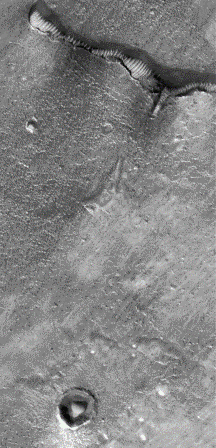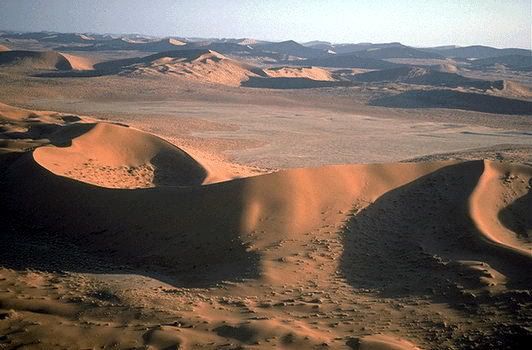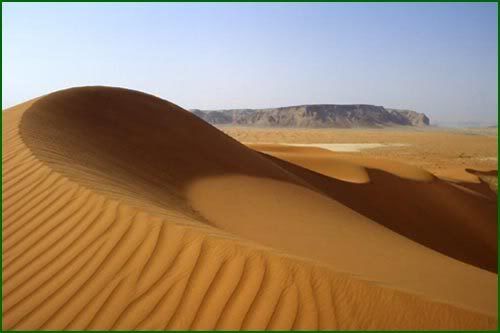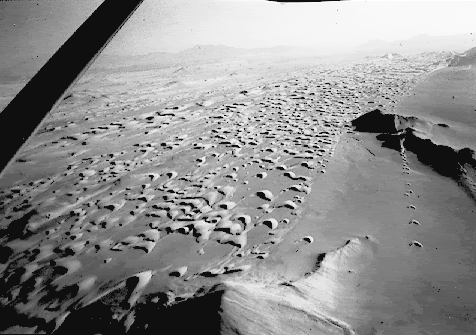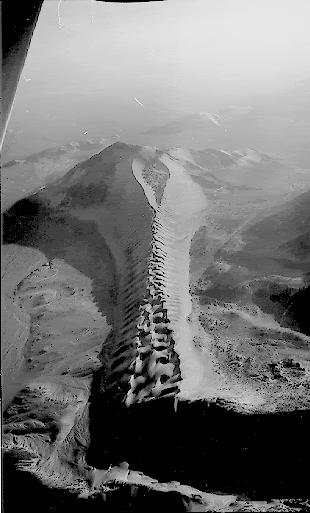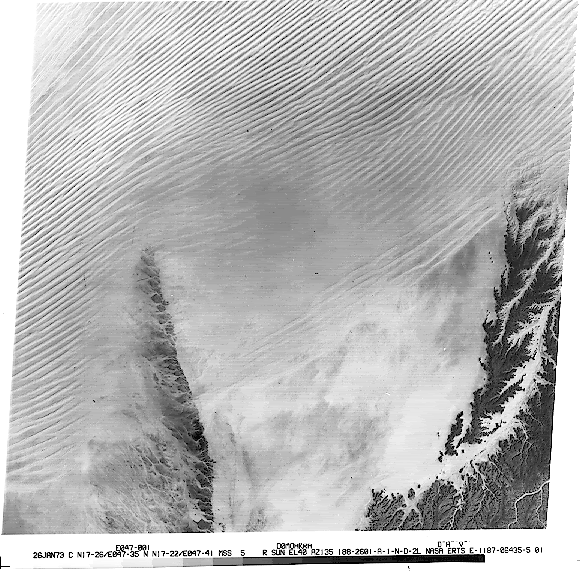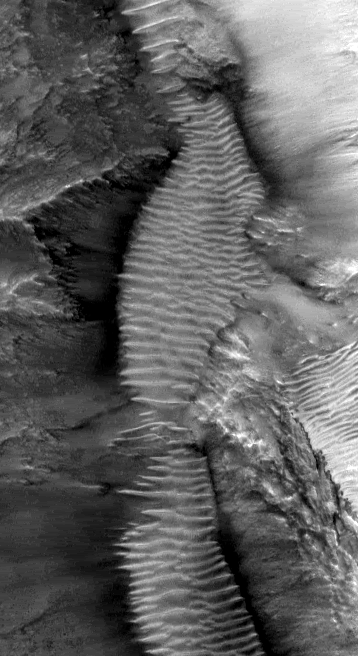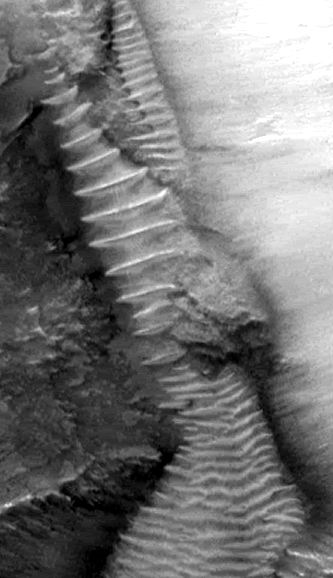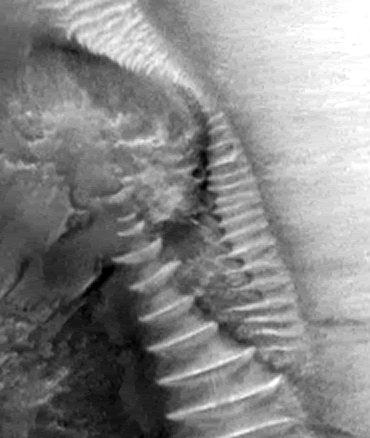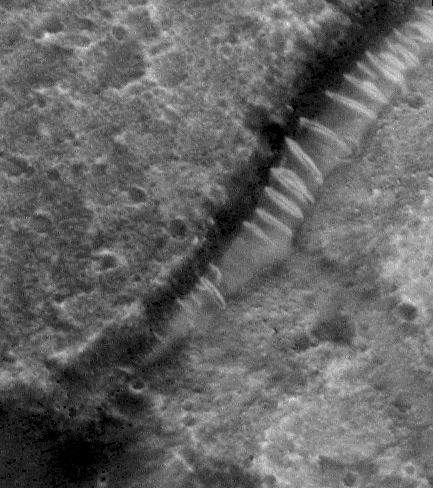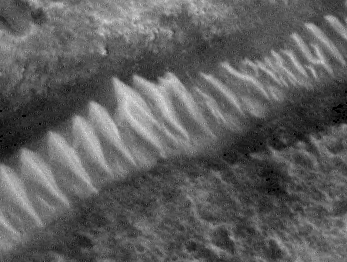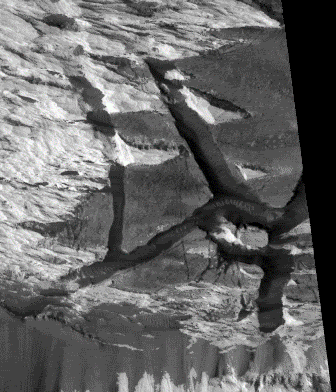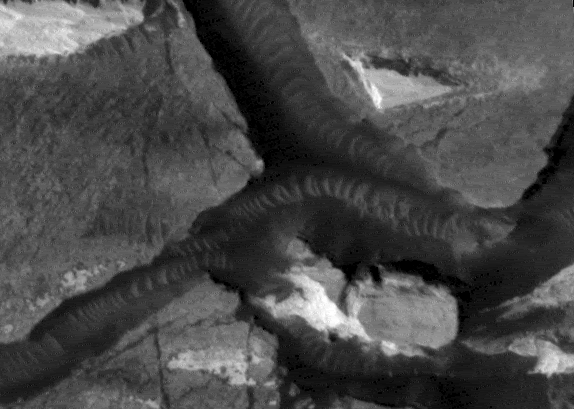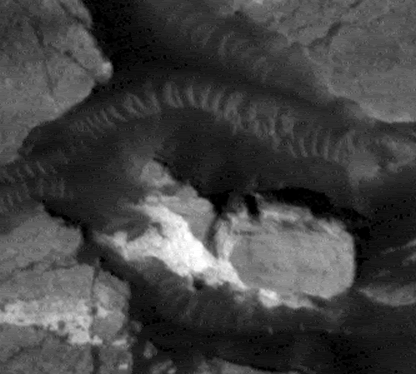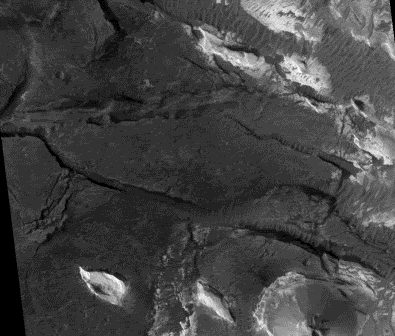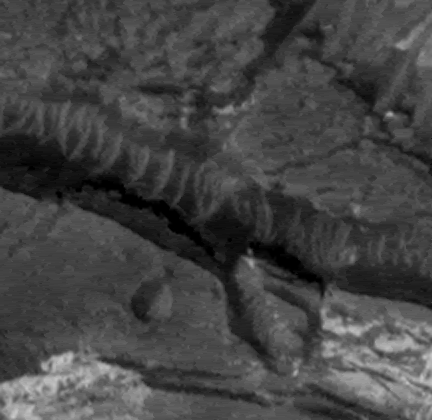- Thank you received: 0
URLs from Meta Research
- neilderosa
-
Topic Author
- Offline
- Platinum Member
-

Less
More
18 years 2 months ago #18794
by neilderosa
Replied by neilderosa on topic Reply from Neil DeRosa
For a simple demonstration of the convex nature of (at least some) tubes, I have inverted M1510228 so that north is up. At a local time of 13.12 decimal hours (around 1:07PM), northern winter, the sun is coming from the lower left (southwest). We can see the shadow cast in the "dome in crater" showing the crater is a hole but the dome is really a dome inside of it. Toward the top of the image is the now inverted tube, (shown above several times). We can clearly see the shadow cast by the tube demonstrating it rises high above the adjacent terrain. For a breakdown of the angles, terrain, and dimensions, see the Lausch paper cited above, which seems to be accurate, although I prefer to orient images to show north for simplicity, and he did not do that.
Neil
Neil
Please Log in or Create an account to join the conversation.
- neilderosa
-
Topic Author
- Offline
- Platinum Member
-

Less
More
- Thank you received: 0
18 years 2 months ago #18823
by neilderosa
Replied by neilderosa on topic Reply from Neil DeRosa
Please Log in or Create an account to join the conversation.
- neilderosa
-
Topic Author
- Offline
- Platinum Member
-

Less
More
- Thank you received: 0
18 years 2 months ago #16337
by neilderosa
Replied by neilderosa on topic Reply from Neil DeRosa
Here's a little tube study for those interested
M1500465 the whole strip compressed
Crop 1. Note fine striations and flat look. But since sun is coming from left in this map projected image, (local time is 13.23 decimal hours, southern summer, image is located at 4.83°S latitude), we can see by the shadows to the left of the tube that the tube is in a trough, but is raised relative to terrain just to the right of tube, (because if the tube were not raised, the section of trough just to the right of tube would be facing the sun and thus lighted. But instead sunlight is blocked by tube).
Moving up the tube
Up further, note the fine striations change to coarse striations giving object the classic “glassy tube” look at this point.
Close up of glassy tube section.
M1500465 the whole strip compressed
Crop 1. Note fine striations and flat look. But since sun is coming from left in this map projected image, (local time is 13.23 decimal hours, southern summer, image is located at 4.83°S latitude), we can see by the shadows to the left of the tube that the tube is in a trough, but is raised relative to terrain just to the right of tube, (because if the tube were not raised, the section of trough just to the right of tube would be facing the sun and thus lighted. But instead sunlight is blocked by tube).
Moving up the tube
Up further, note the fine striations change to coarse striations giving object the classic “glassy tube” look at this point.
Close up of glassy tube section.
Please Log in or Create an account to join the conversation.
- neilderosa
-
Topic Author
- Offline
- Platinum Member
-

Less
More
- Thank you received: 0
18 years 2 months ago #16345
by neilderosa
Replied by neilderosa on topic Reply from Neil DeRosa
A short note while I have a few moments free from my busy workday. I have reviewed the Meta research URLs fairly extensively, along with a number of related images. At the risk of irritating some of the few brave souls who still favor the artificiality hypothesis, I think I’ve come up with some new, tentative conclusions, or a new “working hypothesis” if you will—based on the evidence. I’m working on a paper on the “tubes” so I don’t want to “spill all the beans” here. But in the next few days I’ll make some posts “for the record.”
According to my standards or criteria for possible artificiality, most of the faces posted in the “Keys” topic qualify. I should probably remove 3 or 4, that don’t, not that it would make any difference to others, especially those hardened critics who question or reject the whole enterprise. But to be consistent with my own standards, I will probably clean up that post some by removing the few faces and objects that don’t qualify. Anyway, I’ll be adding “keys” of the few objects from the URLs that I think do qualify, and they may not be what some might expect. As always, I’ll give my reasons. I can’t post good images from this computer so they will come later.
Neil DeRosa
According to my standards or criteria for possible artificiality, most of the faces posted in the “Keys” topic qualify. I should probably remove 3 or 4, that don’t, not that it would make any difference to others, especially those hardened critics who question or reject the whole enterprise. But to be consistent with my own standards, I will probably clean up that post some by removing the few faces and objects that don’t qualify. Anyway, I’ll be adding “keys” of the few objects from the URLs that I think do qualify, and they may not be what some might expect. As always, I’ll give my reasons. I can’t post good images from this computer so they will come later.
Neil DeRosa
Please Log in or Create an account to join the conversation.
- neilderosa
-
Topic Author
- Offline
- Platinum Member
-

Less
More
- Thank you received: 0
18 years 2 months ago #16350
by neilderosa
Replied by neilderosa on topic Reply from Neil DeRosa
One “tube” question I’d like to address is that of the tubes' high albedo, especially the brightness of the cross ribs or striations. Here are some crops from Orme’s M1104220, to view these bright objects again.
Now here are some crops from nearby S0500932 and S0702922 . We can assume that the same or very similar tubes continue into these images. But as we see, the tubes have a much lower brightness here, resembling the normal grays of the terrain. They are much darker in fact than the light-toned terrain nearby. Yet the tubes are still very evident. Perhaps the brightness value of the tubes is not absolute, but is instead relative to the particular camera setting in each image.
Now here are some crops from nearby S0500932 and S0702922 . We can assume that the same or very similar tubes continue into these images. But as we see, the tubes have a much lower brightness here, resembling the normal grays of the terrain. They are much darker in fact than the light-toned terrain nearby. Yet the tubes are still very evident. Perhaps the brightness value of the tubes is not absolute, but is instead relative to the particular camera setting in each image.
Please Log in or Create an account to join the conversation.
- neilderosa
-
Topic Author
- Offline
- Platinum Member
-

Less
More
- Thank you received: 0
18 years 2 months ago #19419
by neilderosa
Replied by neilderosa on topic Reply from Neil DeRosa
The main points I want to make about the tubes are as follows (these points will be supported by visual MOC MGS image evidence with the relevant acquisition parameters as time permits):
1- The high albedo of the tubes may be a function of the camera settings and not the actual properties of the tubes, (see previous post).
2- The same tubes followed “downstream” often change from a tube-like appearance to sief and nearly barchan dune-like structures, where no stretch of the imagination could mistake certain sections of these formations for “tubes.” The tubes almost always follow erosion channels, so the characteristic striations we see may not be the result of wind as much as the result or signature of the fluid that once flowed in the channels (presumably water, but possibly lava, or both when lava later flowed in previously water eroded channels). Where the tube-like appearances are evident, they sometimes are seen to branch in different directions at once, or appear to disappear under ground. I doubt that this is an “illusion” in some cases, but we may simply be seeing the signatures of previous different flows that went in different directions, perhaps at different times. Water or lava could easily flow underground, if a stream encounters an underground cavity or other types of porous terrain.
3- We may have an “apples and oranges” situation in our effort to understand the tubes phenomenon. <b>In other words, we may be looking at two or more different kinds of formations, only one of which may be artificial.
</b>4- <b>A few sections of the tube-like structures—a very few in my opinion—are much more structured and uniform in appearance than all the rest, and these few structures may be the only artificial structures of the lot. If these few examples are indeed natural formations, they will require a special explanation by the specialized scientists who may be able to explain them. </b>
5- These few highly structured tubes seem to be accompanied by some of the ubiquitous faces we see “all over Mars.” But none of the faces associated with tubes have high enough detail, proportion, and orientation, to make a definitive statement about them.
6- One speculation might be that the Builders used the natural formations they saw as a model for the structures they built for whatever reason. The concept of “camouflage” comes to mind here. The builders often seem to have taken the natural terrain and modified it to their needs.
Neil DeRosa
1- The high albedo of the tubes may be a function of the camera settings and not the actual properties of the tubes, (see previous post).
2- The same tubes followed “downstream” often change from a tube-like appearance to sief and nearly barchan dune-like structures, where no stretch of the imagination could mistake certain sections of these formations for “tubes.” The tubes almost always follow erosion channels, so the characteristic striations we see may not be the result of wind as much as the result or signature of the fluid that once flowed in the channels (presumably water, but possibly lava, or both when lava later flowed in previously water eroded channels). Where the tube-like appearances are evident, they sometimes are seen to branch in different directions at once, or appear to disappear under ground. I doubt that this is an “illusion” in some cases, but we may simply be seeing the signatures of previous different flows that went in different directions, perhaps at different times. Water or lava could easily flow underground, if a stream encounters an underground cavity or other types of porous terrain.
3- We may have an “apples and oranges” situation in our effort to understand the tubes phenomenon. <b>In other words, we may be looking at two or more different kinds of formations, only one of which may be artificial.
</b>4- <b>A few sections of the tube-like structures—a very few in my opinion—are much more structured and uniform in appearance than all the rest, and these few structures may be the only artificial structures of the lot. If these few examples are indeed natural formations, they will require a special explanation by the specialized scientists who may be able to explain them. </b>
5- These few highly structured tubes seem to be accompanied by some of the ubiquitous faces we see “all over Mars.” But none of the faces associated with tubes have high enough detail, proportion, and orientation, to make a definitive statement about them.
6- One speculation might be that the Builders used the natural formations they saw as a model for the structures they built for whatever reason. The concept of “camouflage” comes to mind here. The builders often seem to have taken the natural terrain and modified it to their needs.
Neil DeRosa
Please Log in or Create an account to join the conversation.
Time to create page: 0.393 seconds

